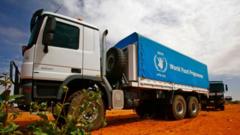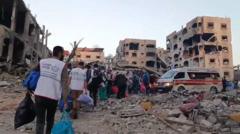On March 28, 2025, a devastating 7.7-magnitude earthquake near Mandalay, Myanmar, resulted in a rising death toll, damage to infrastructure, and widespread panic across Southeast Asia. First responders are facing challenges reaching affected areas, while fears of aftershocks continue.
Major Earthquake Hits Myanmar, Death Toll Rises Amid Widespread Destruction

Major Earthquake Hits Myanmar, Death Toll Rises Amid Widespread Destruction
A powerful 7.7-magnitude earthquake struck central Myanmar, claiming at least 20 lives and causing significant damage across Southeast Asia, including Thailand.
March 28, 2025, 5:56 a.m. ET - A catastrophic 7.7-magnitude earthquake shook central Myanmar at approximately 12:50 p.m. local time, triggering widespread destruction and death across the region. As of the latest reports, at least 20 people are confirmed dead in Myanmar, with additional fatalities in neighboring Thailand, where at least three deaths have been attributed to building collapses.
The earthquake's epicenter was located near Mandalay, the second-largest city in Myanmar, prompting buildings to sway as far as Bangkok, Thailand. Notably, the quake triggered at least one significant aftershock measuring 6.4 on the Richter scale just 12 minutes later. The shallow depth of the quake is believed to have contributed to the severe shaking and extensive damage.
Initial reports indicate critical injuries for over 200 individuals in Mandalay alone, as hospitals faced an influx of patients. Many were forced to evacuate swiftly into parking lots due to structural instabilities, some still tethered to their IV drips and oxygen lines. This mass exodus underscores the fear and chaos gripping the city in the aftermath of the quake.
Destruction was equally grim in Naypyidaw, Myanmar’s capital, where collapsing buildings and bridges aggravated the humanitarian crisis in a nation still wrestling with the effects of ongoing civil strife following a military coup. The casualty figures are expected to rise as emergency response teams can navigate the cluttered streets and damaged communication networks to assess the full extent of the aftermath.
In Thailand, the impact was notably severe in Bangkok, where tremors caused significant disruption. Notable incidents included a high-rise building under construction in the Chatuchak district collapsing, endangering construction workers and passersby who fled for safety. Thai authorities have declared an emergency, urging residents to stay clear of tall structures as fears of aftershocks loom large.
Beyond Myanmar and Thailand, the tremors were felt in areas as far as southern China, where reports indicate minor injuries and building damage in Ruili City, Yunnan Province. The tremors led to alarm in various Southeast Asian cities, resulting in disrupted services and heavy traffic delays as citizens sought refuge from potential aftershocks.
As rescue efforts continue in the hours following the quake, the International Federation of Red Cross and Red Crescent Societies has dispatched teams to support local efforts; however, challenges persist due to downed power lines and communication issues. Eyewitness accounts reveal a harrowing experience as individuals recount fleeing to safety amid falling debris and chaos.
This natural disaster marks one of the most severe earthquakes in the region in years, with implications for recovery and support likely to unfold in the coming days. Reports continue to emerge, emphasizing the need for coordinated humanitarian assistance as Myanmar and its neighbors assess the full impact of this tragic earthquake.
The earthquake's epicenter was located near Mandalay, the second-largest city in Myanmar, prompting buildings to sway as far as Bangkok, Thailand. Notably, the quake triggered at least one significant aftershock measuring 6.4 on the Richter scale just 12 minutes later. The shallow depth of the quake is believed to have contributed to the severe shaking and extensive damage.
Initial reports indicate critical injuries for over 200 individuals in Mandalay alone, as hospitals faced an influx of patients. Many were forced to evacuate swiftly into parking lots due to structural instabilities, some still tethered to their IV drips and oxygen lines. This mass exodus underscores the fear and chaos gripping the city in the aftermath of the quake.
Destruction was equally grim in Naypyidaw, Myanmar’s capital, where collapsing buildings and bridges aggravated the humanitarian crisis in a nation still wrestling with the effects of ongoing civil strife following a military coup. The casualty figures are expected to rise as emergency response teams can navigate the cluttered streets and damaged communication networks to assess the full extent of the aftermath.
In Thailand, the impact was notably severe in Bangkok, where tremors caused significant disruption. Notable incidents included a high-rise building under construction in the Chatuchak district collapsing, endangering construction workers and passersby who fled for safety. Thai authorities have declared an emergency, urging residents to stay clear of tall structures as fears of aftershocks loom large.
Beyond Myanmar and Thailand, the tremors were felt in areas as far as southern China, where reports indicate minor injuries and building damage in Ruili City, Yunnan Province. The tremors led to alarm in various Southeast Asian cities, resulting in disrupted services and heavy traffic delays as citizens sought refuge from potential aftershocks.
As rescue efforts continue in the hours following the quake, the International Federation of Red Cross and Red Crescent Societies has dispatched teams to support local efforts; however, challenges persist due to downed power lines and communication issues. Eyewitness accounts reveal a harrowing experience as individuals recount fleeing to safety amid falling debris and chaos.
This natural disaster marks one of the most severe earthquakes in the region in years, with implications for recovery and support likely to unfold in the coming days. Reports continue to emerge, emphasizing the need for coordinated humanitarian assistance as Myanmar and its neighbors assess the full impact of this tragic earthquake.





















